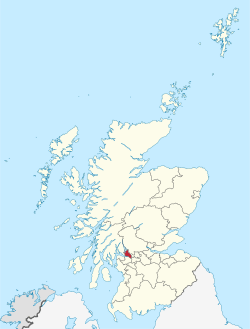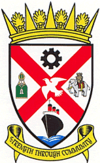West Dunbartonshire
West Dunbartonshire (Scots: Wast Dunbartanshire; Scottish Gaelic: Siorrachd Dhùn Breatann an Iar, pronounced [ˈʃirˠəxk ɣumˈpɾʲɛʰt̪ɪɲ ə ɲiəɾ]) is one of the 32 local government council areas of Scotland. The area lies to the west of the City of Glasgow and contains many of Glasgow's commuter towns and villages, as well as the city's suburbs. West Dunbartonshire also borders onto Argyll and Bute, East Dunbartonshire, Renfrewshire and Stirling.
West Dunbartonshire Wast Dunbartanshire Siorrachd Dhùn Breatann an Iar | |
|---|---|
 | |
 Coat of arms  | |
| Coordinates: 55°59′24″N 4°30′54″W | |
| Sovereign state | United Kingdom |
| Country | Scotland |
| Lieutenancy area | Dunbartonshire |
| Admin HQ | Dumbarton |
| Government | |
| • Body | West Dunbartonshire Council |
| • Control | SNP + Ind minority (council NOC) |
| • MPs | |
| • MSPs | |
| Area | |
| • Total | 61.3 sq mi (158.8 km2) |
| Area rank | Ranked 31st |
| Population (mid-2019 est.) | |
| • Total | 89,130 |
| • Rank | Ranked 26th |
| • Density | 1,500/sq mi (560/km2) |
| ONS code | S12000039 |
| ISO 3166 code | GB-WDU |
| Website | www |
The area was formed on 1 April 1996 from part of the former Strathclyde Region, namely the entire district of Clydebank, and the Dumbarton district less the Helensburgh area. In the Local Government etc. (Scotland) Act 1994 that created the council area its name was Dumbarton and Clydebank; however the council, elected as a shadow authority in 1995, resolved to change the name of the area to West Dunbartonshire.[1]
The West Dunbartonshire area is essentially composed of three parts: the towns of Clydebank, Dumbarton and the Vale of Leven District. The council is administered from Dumbarton, although Clydebank is the largest town.
Governance and politics

The council is run by 22 councillors elected from 6 wards.[2] Following the 4 May 2017 election, resulted in the following political composition:[3]
| Party | Councillors | |
| Scottish National Party | 10 | |
| Labour | 8 | |
| Conservative | 2 | |
| West Dunbartonshire Community Party | 1 | |
| Independent | 1 |
Wards
Six multi-member wards were created for the 2007 election, replacing 22 single-member wards which had been in place since the creation of the council in 1995:
- Lomond (3 seats)
- Leven (4 seats)
- Dumbarton (4 seats)
- Kilpatrick (3 seats)
- Clydebank Central (4 seats)
- Clydebank Waterfront (4 seats)
Independence referendum
On 18 September 2014, West Dunbartonshire was one of the four council areas which had a majority "Yes" vote in the Scottish Independence Referendum at 54% with an 87.9% turnout rate.[4]
Towns and villages
- Alexandria
- Balloch
- Bonhill
- Bowling
- Clydebank
- Dalmuir
- Drumry
- Dumbarton
- Duntocher
- Faifley
- Gartocharn
- Hardgate
- Jamestown
- Linnvale
- Milton
- Old Kilpatrick
- Renton
- Whitecrook
Main sights
- Erskine Bridge
- Dumbarton Castle
- Inchmurrin, the largest freshwater island in the British Isles
- Kilpatrick Hills
- Loch Lomond
- Loch Lomond and the Trossachs National Park
- Overtoun Bridge, a location known for a high number of dog deaths and at least one human death
- River Leven
References
- Footnote to Scottish Statutory Instrument 2004 No. 465
- "West Dunbartonshire Council May 2007 to present". Enline pic. Archived from the original on 31 July 2007. Retrieved 31 July 2007.
- 4 May 2017 Council Election Results - West Dunbartonshire
- "Indyref". BBC. Retrieved 19 September 2014.